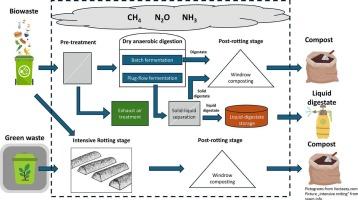生物废物和绿色废物厌氧和好氧处理产生的温室气体排放
IF 7.1
2区 环境科学与生态学
Q1 ENGINEERING, ENVIRONMENTAL
引用次数: 0
摘要
本研究考察了德国的生物废物和绿色废物处理,重点关注堆肥和厌氧干消化(AD)产生的与气候相关的排放。现场分析了各种来源(热电联产装置、泄漏、废气处理和非气密消化池储存)的排放,特别关注堆肥过程的不同阶段。使用开放式动态隧道测量系统对腐烂排放物进行了量化。堆肥过程中不适当的条件和消化后的腐烂会导致大量温室气体(GHG)排放,包括甲烷(CH4)、氧化亚氮(N2O)和氨(NH3)。评估了五个开放式和两个封闭式堆肥设施,以及两个批量操作和三个连续操作的堆肥工厂的排放。与工厂相关的总排放量变化很大,在四个测量活动中,排放因子(EF)范围为22.9至574.0千克二氧化碳当量(eq) Mg−1湿废物(ww),而腐烂过程的排放量范围为16.6至318.6千克二氧化碳当量Mg−1 ww。腐烂过程占总排放量的大部分,平均排放分布表明,CH4占比最大,为66.4%(71.2±14.5 kg CO2-eq Mg - 1 ww),其次是N2O,为31.6%(34.5±14.5 kg CO2-eq Mg - 1 ww), NH3占比最小,为2.0%(1.2±0.3 kg CO2-eq Mg - 1 ww)。堆肥过程中的温室气体排放仅受原料的显著影响,消化物的排放量高于生物废物(p < 0.05)。其他参数如窗高、结构材料混合比、翻转间隔等均无显著影响(p > 0.05)。本文章由计算机程序翻译,如有差异,请以英文原文为准。

Greenhouse gas emissions from anaerobic and aerobic treatment of biowaste and green waste
This study examines biowaste and green waste treatment in Germany, focusing on climate-relevant emissions from composting and anaerobic dry digestion (AD). Emissions from various sources (Combined heat and power (CHP) unit, leaks, exhaust air treatment, and non-gas-tight digestate storage) were analyzed on-site, paying particular attention to different phases of the composting process. Quantification of the rotting emissions was performed using an Open Dynamic Tunnel measurement system.
Inadequate conditions during composting and post-rotting of digestates can lead to significant greenhouse gas (GHG) emissions, including methane (CH4), nitrous oxide (N2O), and ammonia (NH3). Emissions were assessed at five open and two enclosed composting facilities, as well as two batch-operated and three continuously operated AD plants. Total plant-related emissions varied widely, with emission factors (EF) ranging from 22.9 to 574.0 kg CO2–equivalent (eq) Mg−1 wet waste (ww), while rotting process emissions ranged from 16.6 to 318.6 kg CO2–eq Mg−1 ww across four measurement campaigns. Rotting processes account for the majority of total emissions, with the average emission distribution indicating that CH4 represents the largest share at 66.4 % (71.2 ± 14.5 kg CO2–eq Mg−1 ww), followed by N2O at 31.6 % (34.5 ± 14.5 kg CO2–eq Mg−1 ww), while NH3 constitutes the smallest fraction at 2.0 % (1.2 ± 0.3 kg CO2–eq Mg−1 ww). GHG emissions during composting were only significantly influenced by feedstock materials, with digestate showing higher emissions than biowaste (p < 0.05). Other parameters such as windrow height, structural material mixing ratios, and turning intervals had no significant impact (p > 0.05).
求助全文
通过发布文献求助,成功后即可免费获取论文全文。
去求助
来源期刊

Waste management
环境科学-工程:环境
CiteScore
15.60
自引率
6.20%
发文量
492
审稿时长
39 days
期刊介绍:
Waste Management is devoted to the presentation and discussion of information on solid wastes,it covers the entire lifecycle of solid. wastes.
Scope:
Addresses solid wastes in both industrialized and economically developing countries
Covers various types of solid wastes, including:
Municipal (e.g., residential, institutional, commercial, light industrial)
Agricultural
Special (e.g., C and D, healthcare, household hazardous wastes, sewage sludge)
 求助内容:
求助内容: 应助结果提醒方式:
应助结果提醒方式:


